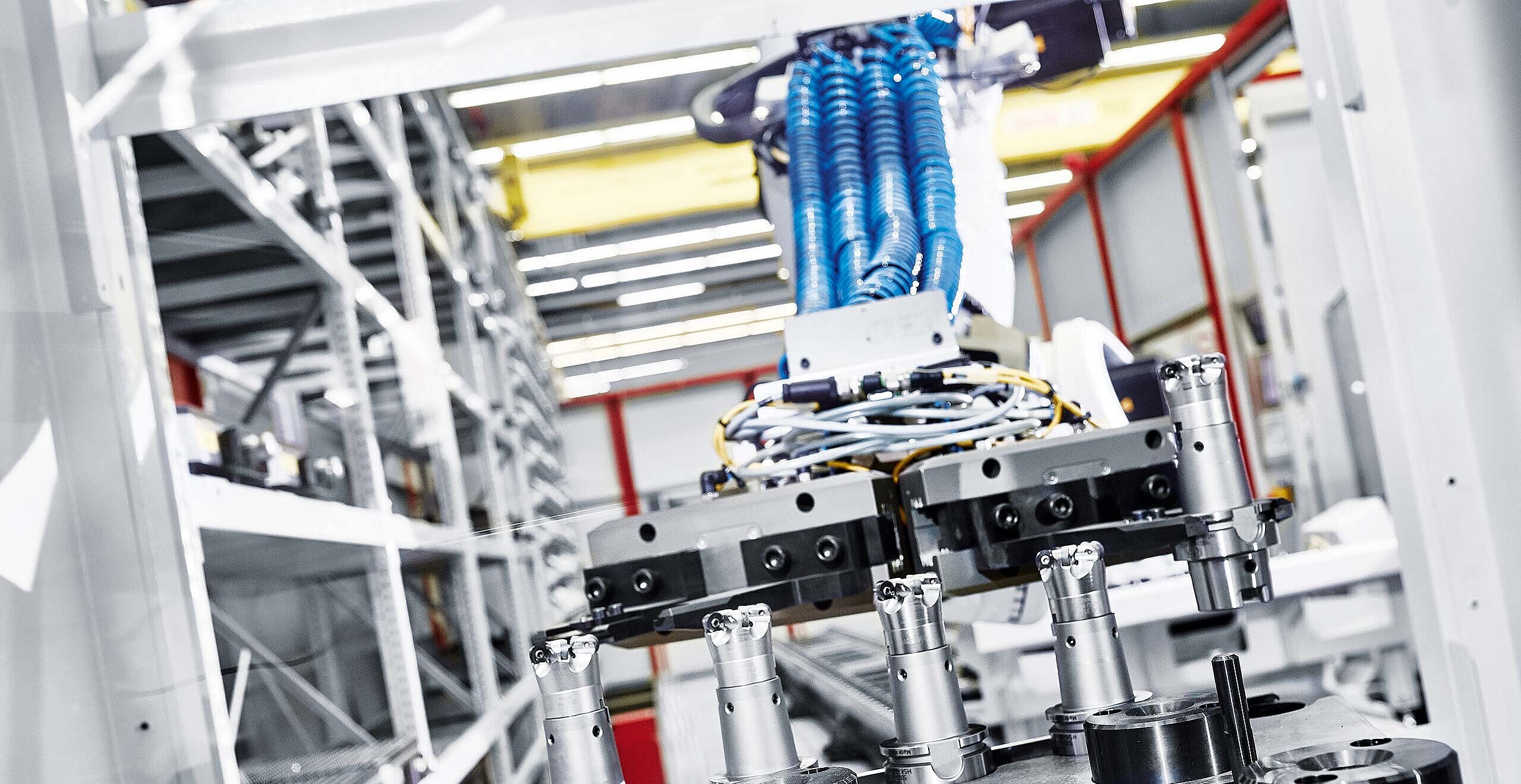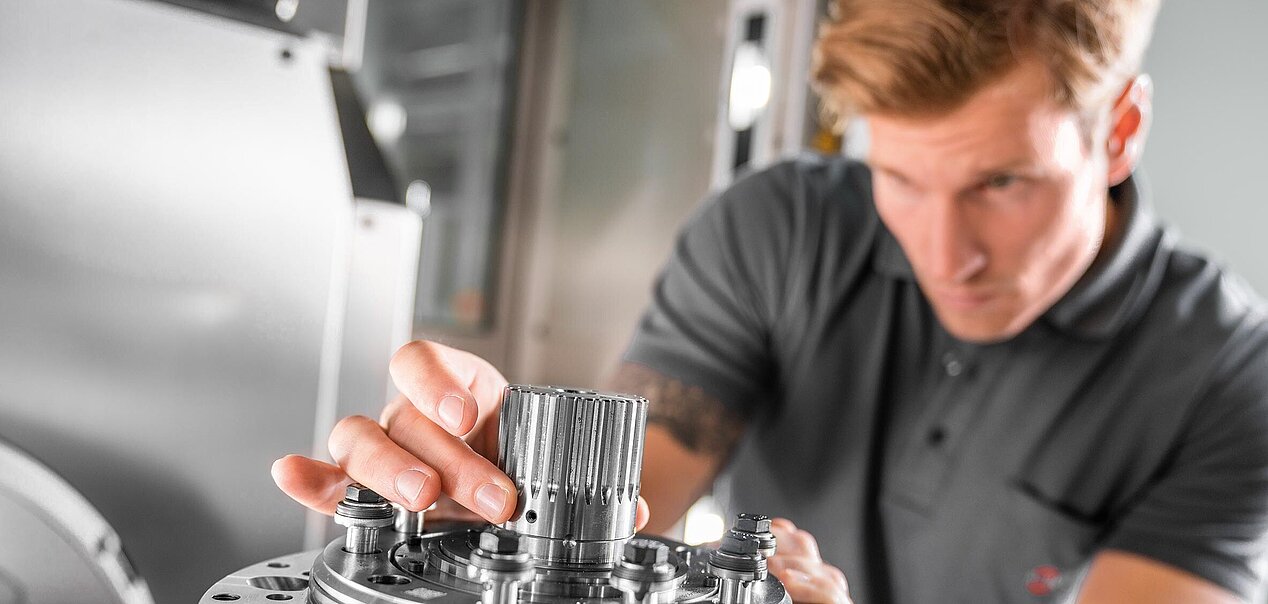Automated manufacturing in industrial tool making
C 42 U PW 850 | South German automobile manufacturer | Automotive industry
From 3 to 5 axis machining to highly automated production of toolmaking components: a major car manufacturer implements industrial tool making with the help of the robot supported manufacturing system from Hermle.
Like hardly any other product, cars and their components require the use of numerous tools to manufacture sheet metal and plastic parts. Design and form, function and haptics as well as performance and quality must, especially here, create an ideal symbiosis. This means extremely high demands on tools for machining of sheet metal and tools for production of injection mould or thermal moulding components. In addition, there are numerous other requirements, such as flexibility of use, also with regard to changes and position changes, to ensure that the costs for production equipment remain within the scope of the calculation, in particular because the increasing number of variations demand more tools than ever, which again demands appropriate capacity for tool making. One possibility to maintain economical manufacturing methods – even if wider ranges of types are required and, as a result, the spectrum of components increases – is the use of modular tools. In this case, depending on the degree of change, just a few segments are exchanged, while the basis tool remains the same. Another possibility is to restructure the tool making process, automating all of the relevant processes as far as possible; this of course can only occur within the scope of what is technically and pragmatically reasonable.
-

Image 4 shows an example of fully automatic hard-material machining of a tool segment on one of the two machining centres C 42 U of the flexible manufacturing system -

In the foreground, the industrial robots for loads of up to 240 kg; in the background, two rack units for workpiece pallets; in the middle, a rack unit for tools; and on the right, once again, a rack unit for workpiece pallets
Reducing working steps, thus saving money and time, with reproducible, precise tool components
At the heart of the new alignment of tool making, according to industrial criteria, lies a tendency to move away from multiple mechanical machining of components by machining them in assembled state. The declared goal, which is now in an advanced stage of realisation, is to have tool components completely finished after a single machining process, so that it is no longer necessary to machine them again in assembled state. Besides maximum and reproducible manufacturing precision, more capacity is also a demand, for example, in the area of milling/complete machining. For this reason resolute investments have been made and are being made in state-of-the-art, highly automated 5 axis machining centres. Following the first talks in 2008, on the topic of "automated 3 to 5 axis complete/simultaneous machining", an extremely intensive machine/supplier evaluation was carried out as of 2010/2011. At the end of this evaluation, a 5 axis CNC high-power machining centre of type Hermle C 42 U was procured. Soon afterwards, a machining centre C 42 U, equipped with an automatic pallet changer PW 850, was bought, paving the way for the next step of automated tool production.
Logical continuation: Machining centres, 5 axis machining centre, with pallet changer, robot supported manufacturing system
The pressure to continue automating in tool making for the car industry is also to be attributed to the fact that new tools and repair parts are produced in the toolmaking departments which often have to compete with external suppliers. In order to guarantee the required flexibility, extensive automation seems unavoidable. For this reason the second machining centre C 42 U was additionally equipped with a pallet changer, making it possible to work autonomously through diverse contracts over longer periods of time. Besides machine performance and higher precision, as well as higher process safety, the very effective and cost-saving collision/crash safety unit with compression sleeves was also a convincing element of the offer – another reason for deciding for Hermle. Within the scope of the aforementioned new alignment of industrial toolmaking, the next project was the move into highly automated tool making/component manufacture, while taking over the manufacture of tool making components from other works. This led to the ambitious idea of installing a highly automated production plant with robot technology. After detailed analysis of requirements and performance, a complete solution was created in close cooperation between the customer and Hermle as manufacturer and system supplier; this complete solution was based around two machining centres and the robot supported workplace as well as tool management. Also in this case, Hermle AG was extremely convincing and was given the contract to implement a complete system for highly automated tool/component production in lot sizes as of one piece.
FFS competence from Hermle, or: Practical availability, 95% and more!
This manufacturing system which, up to now, remains absolutely unique in its particular design, is largely made up of standardised components such as two 5 axis CNC high-power machining centres C 42 U with an NC swivelling rotary table of 420 mm diameter RS 2L, additional linear axis, six rack units with a total of 75 receptacles for pallets of sizes 400 x 400 x 470 mm and 500 x 500 x 470 mm, one further rack unit to supply 180 additional tools, and finally a station for storage/retrieval of four different robot grippers. One particularly clever element of the system is that the robot, as the central material-flow and handling system, takes over the complete handling of the pallets with the work pieces as well as the supply and disposal of the tool magazines at both of the machining centres. Since both machining centres C 42 U are equipped with the additional tool magazine ZM 192 (plus 192 tools), up to 648 tools (plus 2 x machine magazines) are available within the entire system. In this way, autonomous complete machining, also of highly complex tools/components is made possible, in particular because the machining centre tool magazines can be supplied from the additional rack unit, optionally with replacement tools (in case of wear and tear), or with further tools (for machining of component families or of large ranges of diverse components). The connection to an overarching planning system makes it possible to transfer deadlines, CAD data, programs and measurement logs automatically. The leading computer creates the program for the order of manufacture according to the given deadlines. The machine operator can adapt the order depending on the availability and the components that have to be manufactured. Additionally, identical machine equipment, including touch probe and tool breakage monitoring, allow for a highly flexible distribution of the machining tasks to one or the other machine, which makes it possible to plan maximum exploitation of capacity. Finally, it should be mentioned that the precision of the machining centres is so high that in each case measuring operations and evaluations are taken for quality control, at the end of which the workpieces are categorised as OK or not OK.
Summary
The result of several months of intensive operation is a reason to be proud. The system has been in operation since the beginning of 2015 and the goal of 95% availability is almost achieved. The complete integration of all process elements of the mechanical manufacture in a network, as of construction, through the planning stage and programming, right up to simulation on virtual machines, has now made it possible for us to implement fully automatic component manufacture. There is no longer any need for time-consuming loading – after the task has been scanned and the data-approval has been sent to the system and the machine controls, the process starts immediately. In order to allow for uninterrupted material supply, work packages with a maximum of five blanks are supplied via several paternosters; otherwise the manufacturing on the FFS occurs strictly according to contract and/or priority, as is the case with the standalone machines. Together with the use of the efficient Complete and Finished Machining, which also includes hard machining up to HRC 58 + 2, we regard the goals of the industrial toolmaking as achieved.


